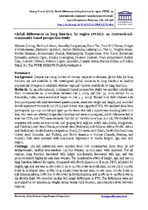| dc.description.abstract | BACKGROUND Despite the rising burden of chronic respiratory diseases, global data for lung function are not available.
We investigated global variation in lung function in healthy populations by region to establish whether regional
factors contribute to lung function.
METHODS In an international, community-based prospective study, we enrolled individuals from communities in
17 countries between Jan 1, 2005, and Dec 31, 2009 (except for in Karnataka, India, where enrolment began on Jan 1,
2003). Trained local staff obtained data from participants with interview-based questionnaires, measured weight and
height, and recorded forced expiratory volume in 1 s (FEV1) and forced vital capacity (FVC). We analysed data from
participants 130–190 cm tall and aged 34–80 years who had a 5 pack-year smoking history or less, who were not
aff ected by specifi ed disorders and were not pregnant, and for whom we had at least two FEV1 and FVC measurements
that did not vary by more than 200 mL. We divided the countries into seven socioeconomic and geographical regions:
south Asia (India, Bangladesh, and Pakistan), east Asia (China), southeast Asia (Malaysia), sub-Saharan Africa (South
Africa and Zimbabwe), South America (Argentina, Brazil, Colombia, and Chile), the Middle East (Iran, United Arab
Emirates, and Turkey), and North America or Europe (Canada, Sweden, and Poland). Data were analysed with nonlinear
regression to model height, age, sex, and region.
FINDINGS 153 996 individuals were enrolled from 628 communities. Data from 38 517 asymptomatic, healthy nonsmokers
(25 614 women; 12 903 men) were analysed. For all regions, lung function increased with height nonlinearly,
decreased with age, and was proportionately higher in men than women. The quantitative eff ect of height,
age, and sex on lung function diff ered by region. Compared with North America or Europe, FEV1 adjusted for height,
age, and sex was 31·3% (95% CI 30·8–31·8%) lower in south Asia, 24·2% (23·5–24·9%) lower in southeast Asia,
12·8% (12·4–13·4%) lower in east Asia, 20·9% (19·9–22·0%) lower in sub-Saharan Africa, 5·7% (5·1–6·4%) lower
in South America, and 11·2% (10·6–11·8%) lower in the Middle East. We recorded similar but larger diff erences in
FVC. The diff erences were not accounted for by variation in weight, urban versus rural location, and education level
between regions.
INTERPRETATION Lung function diff ers substantially between regions of the world. These large diff erences are not
explained by factors investigated in this study; the contribution of socioeconomic, gene | en_US |

